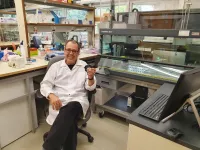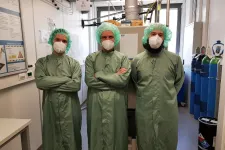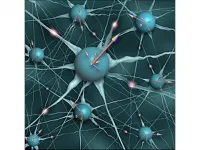INFORMATION:
Silicon waveguides move us closer to faster, light-based logic circuits
2021-02-08
(Press-News.org) For decades, the speed of our computers has been growing at a steady pace. The processor of the first IBM PC released 40 years ago, operated at a rate of roughly 5 million clock cycles per second (4.77 MHz). Today, the processors in our personal computers run around 1000 times faster.
However, with current technology, they're not likely to get any faster than that.
For the last 15 years, the clock rate of single processor cores has stalled at a few Gigahertz (1 Gigahertz = 1 billion clock cycles per second). And the old and tested approach of cramming ever more transistors on a chip will no longer help in pushing that boundary. At least not without breaking the bank in terms of power consumption.
A way out of the stagnation could come in the form of optical circuits in which the information is encoded in light rather than electronics. In 2019, an IBM Research team together with partners from academia built the world's first ultrafast all-optical transistor capable of operating at room temperature. The team now follows up with another piece of the puzzle, a silicon waveguide that links up such transistors, carrying light between them with minimal losses.
Wiring up the transistors of an optical circuit with silicon waveguides is an important requirement to make compact, highly integrated chips. That's because it's easier to place other needed components such as electrodes in its close vicinity if the waveguide is made of silicon. The techniques used for that purpose have been refined for decades in the semiconductor industry.
However, silicon being a notoriously strong absorber of visible light makes it great for capturing sunlight in a photovoltaics panels but a poor choice for a waveguide where light absorption means signal loss.
Making a fence to confine light
So, the IBM researchers thought of ways to use the mature silicon technology while circumventing the absorption issue. Their solution involves nanostructures called high contrast gratings with a striking behavior that some of the team members had already discovered over 10 years ago, albeit for another application.
A high contrast grating consists of nanometer sized "posts" lined up to form a sort of fence that prevents light from escaping. The posts are 150 nanometers in diameter and are spaced in such a way that light passing through the posts interferes destructively with light passing between posts. Destructive interference is a well-known phenomenon by which waves oscillating out of sync cancel each other out at a point in space. It affects light, which is an electromagnetic wave, just as it does sound and other types of wave. In this case, the destructive interference makes sure that no light can "leak" through the grating. Instead, most of the light gets reflected back inside the waveguide. The IBM researchers also showed that absorption of light inside the posts themselves is minimal. All this together translates in losses of only 13 percent along a light travel path of 1 millimeter inside the waveguide. For comparison: Along already only one hundredth of that distance (10 micrometers) in a pure silicon waveguide without the gratings, the losses would amount to 99.7 percent.
Simulations for precise grating design
On its face, the basic idea behind the high contrast gratings looks simple. However, it was indeed surprising when the researchers found out for the first time that they could keep light from being absorbed by a "dark" material like silicon.
Back in 2010, when they first observed the grating effect, it occurred in a laser microcavity which helped because the light amplification by the laser would compensate for the losses. Also, they had the light hitting the gratings at almost 90 degrees which is a sweet spot for the grating effect to kick in. But keeping the losses low in a waveguide without the benefit of the laser gain and at almost grazing light incidence was much more challenging.
To make sure their grating design would be up to the task, the team ran simulations showing how light propagation inside the waveguide would change with varying grating dimensions. They found out that the grating would provide efficient guiding of light over a broad band of wavelengths. All they needed to do was choose the right spacing between the grating posts and make the posts themselves to the right thickness within a precision margin of 15 nanometers. Using a standard silicon photonics fabrication process, those requirements proved manageable. In fact, the experiments confirmed what the simulations had predicted in terms of low loss for visible light in the range between 550 and 650 nanometers.
Potential benefits for optical circuits and beyond
The team found some evidence through simulations that this design can be used to make not only straight waveguides but also guide the light around corners. But they haven't yet run the experiments to confirm this idea. Even if it proves feasible, some further optimization will be needed to keep the additional losses low in that case. Looking ahead, a next step will be to engineer the efficient coupling of the light out of the waveguides into other components. That will be a crucial step in the team's multi-year exploratory research project with the goal of integrating the all-optical transistors they demonstrated in 2019 into integrated circuits capable of performing simple logic operations.
The team believes that their low-loss silicon waveguide could enable new photonic chip designs for use in biosensing and other applications that rely on visible light. It could also benefit the engineering of more efficient optical components such as lasers and modulators widely used in telecommunications.
ELSE PRESS RELEASES FROM THIS DATE:
An end to invasive biopsies?
2021-02-08
In diagnostic medicine, biopsies, where a sample of tissue is extracted for analysis, is a common tool for the detection of many conditions. But this approach has several drawbacks - it can be painful, doesn't always extract the diseased tissue, and can only be used in a sufficiently advanced disease stage, making it, in some cases, too late for intervention. These concerns have encouraged researchers to find less invasive and more accurate options for diagnoses.
Professor Nir Friedman and Dr. Ronen Sadeh of the Life Sciences Institute and School of Computer Engineering have published a study in Nature Biotechnology that shows how a wide range of diseases can be detected through a simple ...
Two-phase material with surprising properties
2021-02-08
In certain materials, electrical and mechanical effects are closely linked: for example, the material may change its shape when an electrical field is applied or, conversely, an electrical field may be created when the material is deformed. Such electromechanically active materials are very important for many technical applications.
Usually, such materials are special, inorganic crystals, which are hard and brittle. For this reason, so-called ferroelectric polymers are now being used. They are characterised by the fact that their polymer chains exist simultaneously in two different microstructures: some areas are strongly ...
Study describes the diversity of genetic changes that cause inherited kidney disease
2021-02-08
A study has described genetic changes in patients with the most common form of hereditary kidney disease that affects an estimated 12.5 million people worldwide. The research, which focussed on Polycystic Kidney Disease (PKD) in Ireland, provides insights into PKD that will assist doctors and patients in the management of this of inherited condition.
The study, led by researchers from the RCSI University of Medicine and Health Sciences, is published in the European Journal of Human Genetics.
In the research, a cohort of 169 patients with PKD in Ireland were analysed. The genetic changes were identified in up ...
Study identifies 'post-traumatic growth' emerging from COVID-19 lockdowns
2021-02-08
Results from a new study which draws on survey data collected during the peak of the first wave of the pandemic suggests that being forced to slow down life, as a consequence of lockdown, has had significant, positive impacts for many people and their families.
The research, recently published in the British Journal of Psychiatry from a team at the University of Bath with international colleagues, analysed survey results from 385 caregivers of children aged 6-16 both in the UK and Portugal. Individuals completed an online questionnaire between 1 May 2020 and 27 June 2020.
This cohort had ...
Ditching the car for walking or biking just one day a week cuts carbon footprint
2021-02-08
Swapping the car for walking, cycling and e-biking even just one day a week makes a significant impact on personal carbon emissions in cities.
'Active transport' - cycling, e-biking or walking - can help tackle the climate crisis according to a new study led by the University of Oxford's Transport Studies Unit and including researchers from Imperial's Centre for Environmental Policy as part of the EU-funded project PASTA: Physical Activity Through Sustainable Transport Approaches.
Meeting greenhouse gas emissions reduction targets requires a significant move away from motorised transport. The team found that shifting to active transport could save as ...
Iodine oxoacids formed in oceans have major impact on climate
2021-02-08
Molecular iodine, a major emission from the ocean, can quickly convert to iodic oxoacids even under weak daylight conditions. These oxoacids lead rapidly to aerosol particles that significantly affect climate and human health.
Iodine-containing vapors that are emitted from oceans are a major source of aerosol particles. "Despite their importance to the climate, the formation of marine particles has been poorly understood," says Siddharth Iyer, Postdoctoral Researcher in Aerosol Physics Laboratory at Tampere University.
In this research, the formation of aerosol particles form from iodine-containing vapours under marine boundary layer conditions were studied. The experiments were carried out in the ultra-clean CLOUD chamber in CERN, where the nucleation and growth rates as well as ...
Cells are collective thinkers
2021-02-08
Cells, like humans, cast votes to make decisions as a group. But how do they know what to vote for? Researchers at the Francis Crick Institute and King's College London have uncovered how cells actively seek information in order to make faster and better collective decisions to coordinate the growth of new blood vessels. This provides a new basis for understanding intelligence in cells.
The process of how cells precisely and quickly coordinate action when they create new tissue is complex. They must collectively decide which cells should take on specific jobs and ensure that not too ...
The quantum advantage: a novel demonstration
2021-02-08
Is a quantum machine really more efficient than a conventional machine for performing calculations? Demonstrating this 'advantage' experimentally is particularly complex and a major research challenge around the world1. Scientists from the CNRS2, the University of Edinburgh (Scotland) and the QC Ware, Corp., (France and USA) have just proved that a quantum machine can perform a given verification task in seconds when the same exercise would take a time equivalent to the age of the universe for a conventional computer. For this demonstration, they combined a complex interactive algorithm that solves a certain type of mathematical problem with limited information and a simple experimental photonics ...
Does Goal 7 Energy for All need a rethink?
2021-02-08
Goal 7 of the Sustainable Development Goals (SDGs) aims to ensure access to affordable, reliable, sustainable and modern energy for all by 2030. Yet according to new research by Copenhagen Business School the poor planning and execution of decarbonisation strategies in emerging markets challenges the aims of Goal 7.
"In the effort to produce renewable energy and decarbonise their economies, emerging countries have neglected the effect on marginalised populations, which could ultimately prove unsustainable for all," says Assistant Professor Jacobo Ramirez from the ...
'Multiplying' light could be key to ultra-powerful optical computers
2021-02-08
An important class of challenging computational problems, with applications in graph theory, neural networks, artificial intelligence and error-correcting codes can be solved by multiplying light signals, according to researchers from the University of Cambridge and Skolkovo Institute of Science and Technology in Russia.
In a paper published in the journal Physical Review Letters, they propose a new type of computation that could revolutionise analogue computing by dramatically reducing the number of light signals needed while simplifying the search for the best mathematical solutions, allowing for ultra-fast optical computers.
Optical or ...



